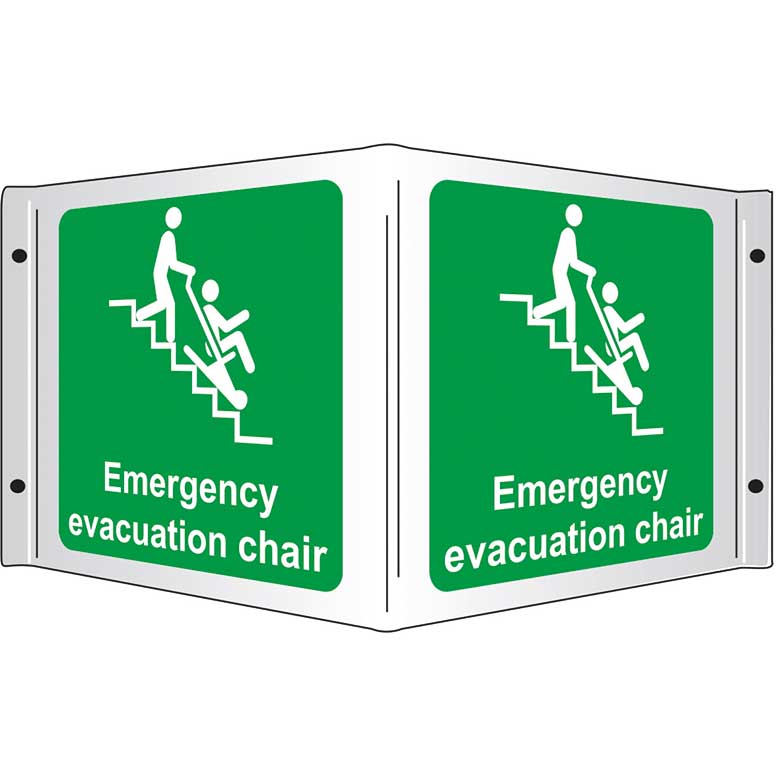
An evacuation (evac) chair or stair chair is a piece of equipment that can be used to evacuate people down stairways during an emergency.
They are a safe way for you to be able to help others who may have a disability to escape during an evacuation because the lifts will not be available.
The features of an evacuation chair
There are certain features that allow the evacuation chair to be easily used in an emergency such as:
Being lightweight
Evacuation chairs are made to be lightweight, so they are easy to manoeuvre and carry even when they’re in use.Being compact
Another feature is that they are compact, this means they take up very little space when being stored in their designated place. This feature makes it a lot easier for you to turn around on landings when using the stair chair.Having wheels
A main feature of the evac chair is the inclusion of wheels. These turn it into a wheelchair when you are trying to help the person into the chair at the start and making your way to your assembly point when you reach the ground floor.The wheels are also helpful when you are going down the stairs as they will guide the chair over the first step.
How to use an evacuation chair step by step

Preparing the chair
- Remove the cover.
- Hold the chair so that it is standing upright on the floor still folded up, unbuckle the restraint strap and then raise the rear handle, making sure that it is locked in place.
- Pull the rear wheels out until they lock in place. Then tilt the chair, so it is on all four wheels.
- Pull the seat forward and downwards.
Helping the person onto the chair
- Tilt the chair forward whilst they are helped onto it and then back to normal once they are seated.
- Secure the person comfortably once they are ready using the chest strap (and others if needed).
Transporting the person and the chair
It is recommended that you have two people to manoeuvre the chair where possible. One person going down the stairs first while the second holds the rear handle.
- Push the chair towards the top of the stairs, then stop slightly away at an angle to the top step.
- Tilt the chair forward, so that the person’s weight is off of you then fold away the back wheels.
- Have one person go down a couple of steps before the second person moves the chair to the top step and make sure the wheels are square to it. The person going first will be able to make sure that you are in the correct position.
- Once correctly positioned and all of you are ready, manoeuvre the wheels over the first step.
- Ensure that the track is at the right angle to continue to move down the stairs at a steady pace and that you are holding the rear handle correctly to avoid injury. The person at the feet can help with this by holding either the seat frame or the bar at the base of the chair.
- If you must pass a landing, tilt the chair so that the passenger’s weight is on the front wheels before turning around the bend.
Reaching the ground floor
- Move the chair far enough away from the stairs so that you have enough room to put down the back wheels again.
- Tilt the chair forward, like you did before going downstairs, and fully extend the rear wheels out so that they lock into place.
- You are free to move onto your meeting point.
Are evacuation chairs a legal requirement?
There is a legal requirement that ‘in the event of danger, it must be possible for persons to evacuate the premises as quickly and as safely as possible’ as laid out in The Regulatory Reform (Fire Safety) Order 2005.The Building Safety Act 2022 also states that you ‘must provide such assistance and encouragement to relevant persons as it considers appropriate’ in the event of an emergency.
Our evacuation chairs and signs
Where should an evac chair be placed?
There are other methods of transport for a casulty or in an emergency, such as a stretcher or a basket stretcher. Further products like this can be found in our collection.
Read our other blogs for more information on first aid or contact us for further advice and information on our products.
By Sarah Mason
Explore more:









